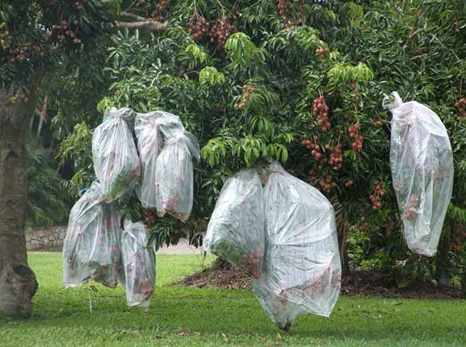How to
Help
HOW TO HELP
WHAT CAN
YOU DO?
Join us and become a Support member or an Active Member.

Backyard
Fruit Tree
Protection
If you must use netting, individual fruit trees can be protected from wildlife by using durable light-coloured knitted (visible at night to nocturnal animals) netting stretched tightly over a frame. An easy way to do this is using lengths of metal, timber or polypipe which can be inserted over star pickets driven into the ground with spacer bars of pipe or wood to stabilise the frame at the top. Stretch mesh tightly over this frame and peg it securely to the ground.
An adult flying fox can weigh over 1 kilogram so the netting must be able to withstand the ‘bounce’ test – when you push your hand onto the netting it must not cave in around your hand.
SUGGESTED
Flying-fox
food plants

Bottlebrush

Swamp Bloodwood

Eucalypt
Eucalypts Allies
- Corymbia citridora – Lemon Scented Gum
- C. intermedia – Pink Bloodwood
- C. ptychocarpa – Swamp Bloodwood
- E. curtisii – Plunket Mallee
- E. tessellaris – Morton Bay Ash
- Lophostemon suaveolans – Swamp Box
Banksia
- B. serrata – Old Man Banksia
- B. integrifolia – Coastal Banksia
Lillypilly
- Acmena smithii – Pink-fruited Lillypilly
- Syzygium oleosum – Blue Lillypilly
Paperbark
- Melaleuca leucodendron – Weeping Paperbark
- M. quinquenervia – Broad-leaved paperbark
- M. viridiflora – Green-flowering Paperbark
Fig
- Ficus coronata – Sandpaper Fig
- F. obliqua – Small-leaved Fig
Bottlebrush
- Callistemon salignus – White Bottlebrush
- C. viminalis – Red Northern Bottlebrush
Grevillea
- G. pteridifolia – Orange Grevillea
- G. robusta – Silky Oak
Beach Almond White Cedar
- Terminalia arenicola
- Melia azenderach
Favourite Flying Fox Food Trees: What to Plant
How to Help
MICROBAT BOXES

Did you know that many of our microbat species are hollow dependent? This means that they live during the daylight hours inside the hollows of trees, sometimes even hollow branches. Many other animals also seek hollows to live in including birds, possums and gliders. It can take decades, if not hundreds of years, for a tree to develop a hollow suitable for wildlife inhabitants.
These old trees are sadly disappearing due to land clearing. Councils may also remove a hollow tree or hollow limbs from trees which are presumed to pose a danger to the public in parks and reserves.
Bats are also known to use roofs and walls in dwellings if they cannot find a suitable hollow. If homeowners are unhappy with their tiny boarders, there are humane ways to exclude them from homes. This is why artificial roost sites are so important as they often provide an alternative, and microbats do use them.
Designs and instructions to make simple bat boxes can be found online, or can be purchased readymade. We recommend Hollow Log Homes
Please note that in Australia the young of microbats are born in late spring and remain with their mothers until the end of January. Any attempt at gentle bat eviction should be made in Autumn, or at least after February and before June when it can be certain that the young are fully independent.
How to Help
Useful publications:

Build a Microbat Box

Boxes for Bats

Bats and Pruning Tips

